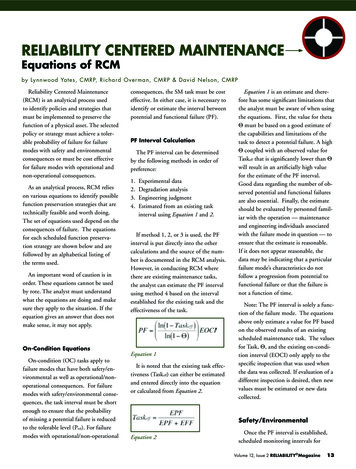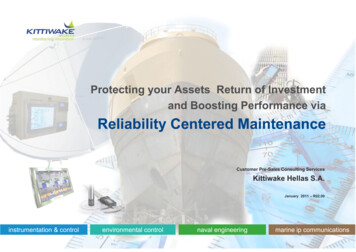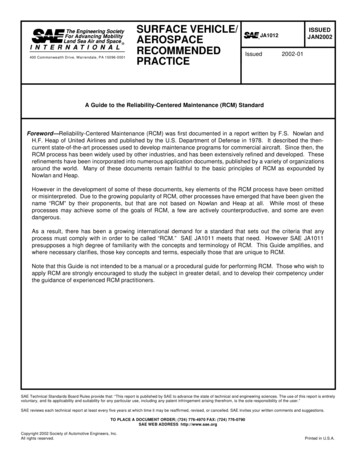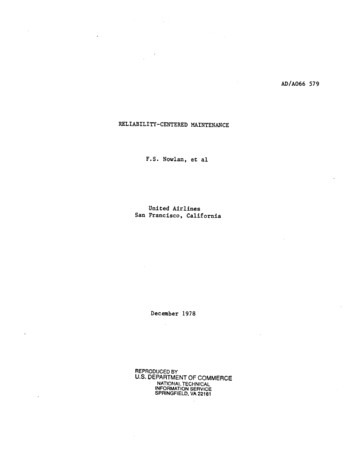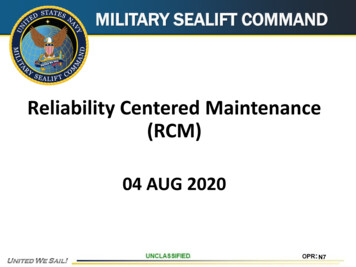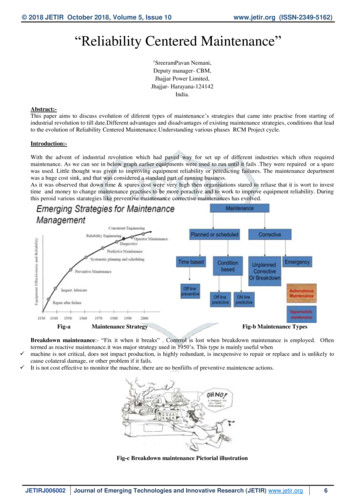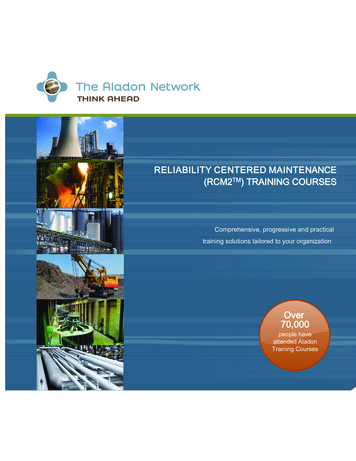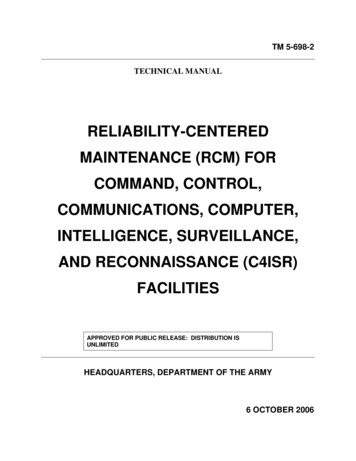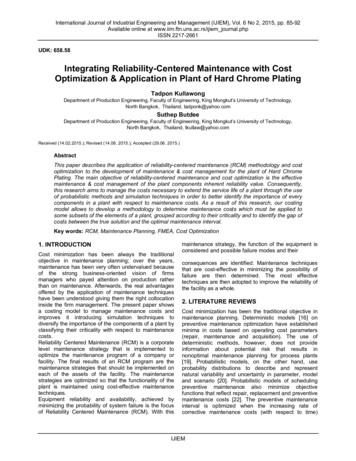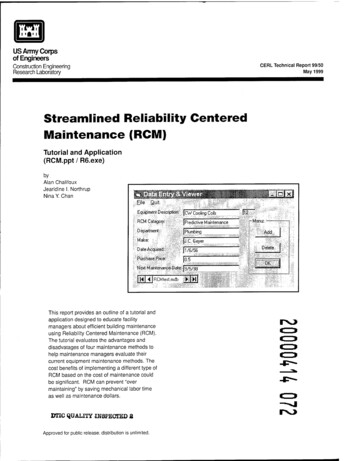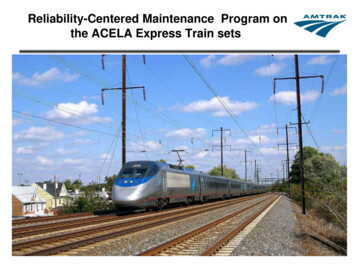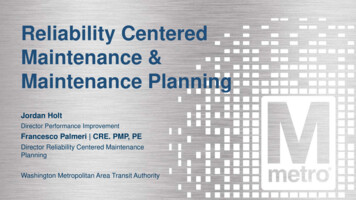
Transcription
Reliability Centered . -----· - : , - - - -: i 'III'---; ; . . . , -. . . . . - - (Maintenance - & -·--- - - ---- -i- - --- - - ,Maintenance Planning . . - --,.-.,,/, . I --t. Jordan HoltDirector Performance Improvement-,-----:.---.--: --- -1 - IIII I - . . '. . - - - - -- - I -Director Reliability Centered Maintenance - j . I- I.I IFrancesco Palmeri CRE. PMP, PEPlanning- ·---·- - -· ·- - ---II II -I -- - 1·: - I. .-:I .- - - "IWashington Metropolitan Area Transit Authority1 IWASHINGTON METROPOLITAN AREA TRANSIT AUTHORITY - - -I - -
Key Referencesa.Nowlan & Heap (Dec 1978), Reliability Centered Maintenance, United Airlines, SanFrancisco, CA, USA.b. John Moubray (1990), RCM2, Industrial Press Inc, NY, USAc.SAE International Standard JA1011 (Aug 2009), Evaluation Criteria for RCM Processesd.SAE International Recommended Practice JA1012 (Aug 2011), A Guide to the RCMStandarde.Marius Basson (2018), RCM3, Industrial Press Inc, NY, USAAnother very useful referencea.2Doc Palmer (1999), Maintenance Planning & Scheduling 3rd Edition, McGraw Hill, NY,USAWASHINGTON METROPOLITAN AREA TRANSIT AUTHORITY
Historical Timeline of the Notable Developments in RCM1960 MSG 1&2 developedby aviation industry1980 MSG31988 MSG3Rev 1MSG inaviation1993 MSG3Rev 22001 MSG3.2 0012002 MSG3.2 002 1978 Nowlan & Heap report “RCM” publishedThe developmentof RCM 1981 RCM applied outside aviation for the first time 1986 MIL STD 2173 Navair 404 NES 45 1999 SAE JA1011 & SAE JA10121990 John Moubray “RCM2”AladonRCM2/32004 “RCM3” Risk-based RCM19603197019801990WASHINGTON METROPOLITAN AREA TRANSIT AUTHORITY200020102020
Formal DefinitionsWhat is Reliability Centered Maintenance (RCM)? Nowlan & Heap: A logical discipline for the development of scheduled maintenanceprograms to realize the inherent reliability capabilities of equipment. RCM2: A process used to determine what must be done to ensure that any physicalasset continues to do what its users want it to do in its current operating context. RCM3: A process used to define the minimum required safe amount of maintenance,engineering and other risk management strategies to ensure a tolerable level of safetyand environmental integrity and cost effective operational capability as specified in theorganization’s asset management standards.4WASHINGTON METROPOLITAN AREA TRANSIT AUTHORITY
Steps of the RCM3 Process--- ---The eight (8) steps of RCM3:Step 1: What are the operating conditions? (Define the operating context)Step 2: What are the functions & performance stds? (What do users want it to do)Step 3: In what ways can it fail? (Define the failed states)Step 4: What causes it to fail? (Determine failure causes & mechanisms)Step 5: What happens when it fails? (Determine failure effects & consequences)Step 6: What are the risks associated with each failure? (Inherent risks)Step 7: What must be done to reduce intolerable risks to a tolerable level? (Proactive riskmanagement)Step 8: Can anything be done to reduce tolerable risks in a cost effective way? (Default riskmanagement)5WASHINGTON METROPOLITAN AREA TRANSIT AUTHORITY
Proactive Risk ManagementRisk Probability x Consequences In order to reduce an Intolerable risk to a Tolerable level, we have three (3)choices. We could:a. Reduce the Probability of occurrence through proactive maintenance,b. Reduce the Severity of consequences through a one-time change(modification, training, change in process or procedures),c. If possible; do both (depending on the severity of the consequences).6WASHINGTON METROPOLITAN AREA TRANSIT AUTHORITY
Proactive Task Options--- -- Predictive or condition-based maintenance Preventive maintenance – scheduled restorations Preventive maintenance – scheduled discards Failure finding tasks (only for protective devices) Functional checks One-time changes (Modification, Training, Procedures).7WASHINGTON METROPOLITAN AREA TRANSIT AUTHORITY-
Fundamentals of Maintenance & ReliabilityGeneration I – Maintenance / Design Philosophy Run everything to failure - repair or replace as required (Run to failure)Generation II – Maintenance / Design Philosophy Assume all components have a useful life limit. Replace components beforethey reach that useful life limit (Safe life) Add redundancy (Fail safe)8WASHINGTON METROPOLITAN AREA TRANSIT AUTHORITY
Fundamentals of Maintenance & ReliabilityGeneration III – Maintenance / Design Philosophy Design for Reliability - only do maintenance when required (Damage tolerant) Introduce Condition Monitoring Adopt a Condition Based Maintenance approachGeneration IV – Maintenance / Design Philosophy Industrial Internet (IIoT) Making use of the real time data capture and wireless technology Integration with the Computerized Maintenance Management System9WASHINGTON METROPOLITAN AREA TRANSIT AUTHORITY
Fundamentals of Maintenance & ReliabilityHazard RateIdealized bathtub curve model for the time to failure of a componentInfantMortalityIIIIIIIIUseful LifeIIIIIIIIIIIIIIIIIIIWear OutTime10WASHINGTON METROPOLITAN AREA TRANSIT AUTHORITY
Fundamentals of Maintenance & ReliabilityIdealized effect of Maintenance on the bathtub curveHazard RatePreventativeMaintenance11InfantMortalityUseful LifeExtension ofUseful LifeWearOut-------WASHINGTON METROPOLITAN AREA TRANSIT AUTHORITYTime
Fundamentals of Maintenance & ReliabilityRealistic effect of Maintenance on the bathtub curveHazard Rate Maintenance Overhauls Modifications12Reemergence ofthe InfantMortalityRegion ----------------------------------------WASHINGTON METROPOLITAN AREA TRANSIT AUTHORITYTime
Fundamentals of Maintenance & ReliabilityHazard RateIdealized view of maintenance optimization13InfantMortalityIIIIIIIIUseful LifeIIIIIIIBest windowto performmaintenanceWear OutIIIIIWASHINGTON METROPOLITAN AREA TRANSIT AUTHORITYTime
Historical Failure PatternsResearch shows the following six failure patterns across many industries.Originally performed by United Airlines and Boeing as part of the 747 program (MSG 1 & 2)4%)A2% BI- - -, /Genenerarallllyy appliliees tor------1 11% - Might Isimimpple items or complelexx I benefit from IIIIlimitonIiteems with dominaitinantntage III operatingfaililurefaure modes.5% CI7% D - -14 % E68 % F14AssociaAssiatted with complex 1r------89% II No benefitequipuipmment such asII from limit onelectroroniniccs, hydydraraululicicageIoperatingand pneumumaatic sysysttems.bWASHINGTON METROPOLITAN AREA TRANSIT AUTHORITY
Explaining Useful LifeUseful LifeAverageLost LifeMean LifeTime15WASHINGTON METROPOLITAN AREA TRANSIT AUTHORITY
What does all this mean for WMATAHistorically, WMATA relies on OEM maintenance program for the entirelifecycle of our Assets’ Time Based Maintenance is prevalent Little to No consideration of Operational Performance and/or Changes to ourOperating Context Little to No consideration of adopting a Condition Based Maintenance approach PM Compliance is consistently above 90% and yet over 40% of our maintenanceis corrective action16WASHINGTON METROPOLITAN AREA TRANSIT AUTHORITY
Benefits of Adopting a Condition Based Maintenance ApproachPoint where Failure Point where Failurecan start to bebeginsMeasuredCondition\17/P . - .- . - .- .IIIIIIIIIIIIIIIIIIIIIOil Analysis(Months). ----- ·-Condition Monitoring allows you tomaximize the P-F Interval and move to aProactive maintenance culture- ',- .- .- . - .- .- .- . - .- .- .-. - . - ·-·-· '!Ii, , .;::-, · -. ·-· ''Vibration(Weeks - Months)Acoustics '' \FPoint whereFailure occursP- F IntervalWASHINGTON METROPOLITAN AREA TRANSIT AUTHORITYTime
RCM3 Decision Diagram15 H CIIHCIIMllOII TISITKHIW.I.YFEASIILUH IIOlml lOll'1ET1'Mii lhelaslc be,iillletnlmHlethe ristand DmlfCllslleS 1hlm'lllf'fl!llil. · 1het.iliue (E:(us51,11:ml.crmmql!IET2DO 11ll SCIUOOlll) RlSTDltlTIOII TJ5IEp3Y 5ls111Ete,a fimbleage111t11R U isa, d iool!ase · the o i1iaml W.11 lhelaslc be.ibletnraiHlethelistand Dmlf,1r1&11Ililjaf'3illft!Do mm'!C1151 les,1hrmlllfbiIICIXD·aftm is;,age?lhe fl!llil. . 1het.ilull! (E:(ust3!I esmll! ,item tom orig· I51!a:mliCJdamql!NIOy·O'.llllffi:o!ISJUOUIIIJrul lllSUltDll51THUIIICll.l.'J Wlll:LIEU:O WOfiU llOIIOOJ l r!I r#fiii lrnjli lljj§ i·PiiM: ii Ef& dIs lb!r1! adt!limtle w'hen!lberl! is a1rajid i;cra.se lhemmlmlrlill pnihah 1tJ d 15 I SOIIDIUI IHTCIUllOII TISIllOIIIWU FUSIIUINIWOffl DCIIIKPET3ffll!it failull!5o:GJ I15 I SOIIDIUI DISOII WIllOIIIWU FUSIIU wom DCIIIKPiifb!rlhis;,;,gJ!!''Mii lhelaslc be,ii1Jle1DlslhEte a d!fimbleage111tia:e U is,a, d inmme 'the o i1iaml OOHlethelishnd Dmlf m1 leS 1h!mil DIiri&llililj af'3il1n ! Do mm'!lfl!llil1h1!11!re5 IIIDII afta isage?! .,. .,.,,0 I iFORJ1JM11' lllllfillllE T.WSK, ruoCUECI I.FA I.Oll'ER ORDIEil 1llSK J§lTECUIIIUU!.f FWIII-U !II UWOlinl001116.!f m , m.HlT Till M.llfl(OST-IFFEClTIYE ROIJlTIIII lTMl.118- WASHINGTON METROPOLITAN AREA TRANSIT AUTHORITY ,Ull NE-TIIIME CUN GE,MAYBE Ol'Sl,RABU---r9J--- -A ONE,-1i1IME (H1lN:GE MArt' Bf llfSIRl.flU
RCM & Maintenance Planning**Analyze performance** of programs in place and loop back if furtherrefinement required- roved M lnt. Poll . cyP.lannin.g. & . ullrig*19WASHINGTON METROPOLITAN AREA TRANSIT AUTHORITY 8·Worl(DocumeotWork
RCM & Maintenance Planning--- ---RCM at WMATA Around 100 people trained via six 3-day sessions Six deep dives conducted with 7th planned Chosen based on reliability reporting Switches, track circuits, DC breakers, Track/third rail, Railcar pneumaticsystem, Railcar doors Two weeks (about a week on proces and a second week on the system) Cross-section of maintenance, operations and engineering staff Working through implementing deep dive recommendations20WASHINGTON METROPOLITAN AREA TRANSIT AUTHORITY
Common Myths about RCM “It’s too hard ” “It takes too long ” “It’s too expensive .” “That’s just an Aviation thing; it won’t work in our industry .” “That’s just another name for condition monitoring .”21WASHINGTON METROPOLITAN AREA TRANSIT AUTHORITY
Summary RCM is a process (structured, scientific, repeatable, defendable) It is not new .RCM has been around for over 40 years When applied correctly, RCM will provide the best maintenanceprogram for your Asset given the Operating Context & Riskprofile. Step 7 provides the pathway for addressing Risk proactively22WASHINGTON METROPOLITAN AREA TRANSIT AUTHORITY
Reliability Centered Maintenance & Maintenance Planning Author: D O T - Federal Transit Administration Subject: DOT is committed to ensuring that information is available in appropriate alternative formats t
